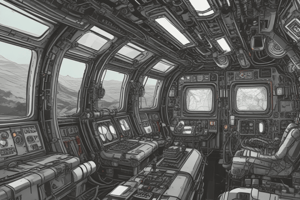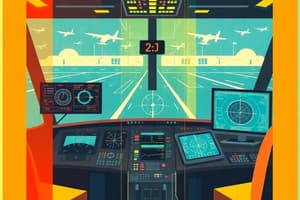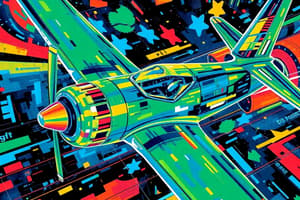Podcast
Questions and Answers
What happens when the active servojack fails?
What happens when the active servojack fails?
- Both jacks switch to centering mode.
- The failed jack is repaired automatically.
- The other jack remains inactive.
- The damped jack becomes active. (correct)
What electric control system normally manages the elevators and THS?
What electric control system normally manages the elevators and THS?
- ELAC1
- SEC1
- ELAC2 (correct)
- FCDC
What is the deflection limit for elevators when positioned nose down?
What is the deflection limit for elevators when positioned nose down?
- 30°
- 4°
- 17° (correct)
- 13.5°
What occurs if neither jack is being controlled hydraulically?
What occurs if neither jack is being controlled hydraulically?
What is the maximum upward deflection of the THS?
What is the maximum upward deflection of the THS?
How are the two hydraulic motors that drive the stabilizer controlled?
How are the two hydraulic motors that drive the stabilizer controlled?
What happens to the deflection of the remaining elevator if one elevator fails?
What happens to the deflection of the remaining elevator if one elevator fails?
What data do Flight Control Data Concentrators (FCDCs) acquire?
What data do Flight Control Data Concentrators (FCDCs) acquire?
What system monitors aircraft systems for faults and alerts pilots?
What system monitors aircraft systems for faults and alerts pilots?
Which components are interconnected and control rudder movement for yaw?
Which components are interconnected and control rudder movement for yaw?
What helps maintain a desired pitch attitude in an aircraft?
What helps maintain a desired pitch attitude in an aircraft?
Which parameters are vital for the data received by the FADEC to be displayed in the ECAM?
Which parameters are vital for the data received by the FADEC to be displayed in the ECAM?
What is one of the functions of the FADEC system?
What is one of the functions of the FADEC system?
What does the fly-by-wire system utilize for controlling aircraft movements?
What does the fly-by-wire system utilize for controlling aircraft movements?
Which of the following is NOT a primary flight control surface?
Which of the following is NOT a primary flight control surface?
What kind of redundancy does the FADEC system feature?
What kind of redundancy does the FADEC system feature?
Flashcards
Damping mode
Damping mode
A flight control mode where the jack follows surface movement to avoid rapid changes or oscillations, helping to reduce vibrations.
Centering mode
Centering mode
A flight control mode where the hydraulic jack automatically stays in the neutral position, maintaining the surface in its appropriate location.
Flight Control Data Concentrators (FCDCs)
Flight Control Data Concentrators (FCDCs)
A component that gathers critical flight data from different control systems and distributes it to other systems like the EIS.
Elevator deflection limits
Elevator deflection limits
Signup and view all the flashcards
Stabilizer Control
Stabilizer Control
Signup and view all the flashcards
Elevator Control Systems (ELAC)
Elevator Control Systems (ELAC)
Signup and view all the flashcards
Hydraulic Jacks
Hydraulic Jacks
Signup and view all the flashcards
Failure Modes (aircraft control)
Failure Modes (aircraft control)
Signup and view all the flashcards
CFDS (Centralized Fault Display System)
CFDS (Centralized Fault Display System)
Signup and view all the flashcards
Sidesticks
Sidesticks
Signup and view all the flashcards
Rudder Pedals
Rudder Pedals
Signup and view all the flashcards
Speed Brake Lever
Speed Brake Lever
Signup and view all the flashcards
Trimmable Horizontal Stabilizer Handwheels
Trimmable Horizontal Stabilizer Handwheels
Signup and view all the flashcards
FADEC System
FADEC System
Signup and view all the flashcards
FADEC functions
FADEC functions
Signup and view all the flashcards
Fly-by-wire system
Fly-by-wire system
Signup and view all the flashcards
Study Notes
Flight Control Systems
-
Jacks: The jacks follow surface movement (damping) and are hydraulically retained in the neutral position (centering). One jack is active, the other damped during normal operation. Maneuvers can switch the second jack to active mode. If one jack fails, the other takes over, failing one automatically switching to damping mode. If neither is electrically or hydraulically controlled, both switch to centering or damping mode as appropriate.
-
Elevator Deflection Limits: To prevent excessive stress on the tailplane and fuselage, deflection of the remaining elevator is limited if one fails.
-
Stabilizer Control: The stabilizer is driven by a screwjack powered by two hydraulic motors controlled by: electric motors (three options) or the mechanical trim wheel.
-
Control Surfaces: Pitch control is handled by two elevators and a Trimmable Horizontal Stabilizer (THS).
-
Deflection Limits (Control Surfaces): Elevators - 30° nose up, 17° nose down; THS - 13.5° nose up, 4° nose down.
-
Electrical Control: ELAC2 normally controls elevators and THS. Green and yellow hydraulic jacks power the left and right elevators, respectively. One of three electric motors drives the THS.
-
Failure Modes: If ELAC2 fails, control shifts to ELAC1. If both ELACs fail, control transfers to SEC1 or SEC2 based on available hydraulic systems. The THS motor reconfigures in case of failure.
Flight Control Data Concentrators (FCDCs)
-
Function: FCDCs acquire data from ELACs (Elevator Aileron Computers) and SECs (Spoilers Elevator Computers) concerning flight control surface positions and relevant parameters.
-
Data Transmission: FCDCs transmit this data to the Electronic Instrument System (EIS) and Centralized Fault Display System (CFDS).
-
EIS (Electronic Instrument System): Displays critical flight information (airspeed, altitude, engine parameters) to pilots.
-
CFDS (Centralized Fault Display System): Monitors aircraft systems for faults and alerts pilots to issues.
Pilot Controls
-
Sidesticks: Independent pilot controls for pitch and roll.
-
Rudder Pedals: Interconnected pedals controlling yaw.
-
Speed Brake Lever: Deploys speed brakes to increase drag.
-
Trimmable Horizontal Stabilizer Handwheels: Adjust the stabilizer for trim to maintain desired pitch attitude.
FADEC (Full Authority Digital Engine Control) System
-
Functions: Controls gas generators, protects against engine exceeding limits, manages power, and automatically and manually starts engines.
-
Redundancy: Two-channel redundancy.
-
Power Source: Magnetic alternator for internal power source.
-
Location: Mounted on the fan case.
-
Interface: Engine Interface Unit (EIU).
Aircraft Control Systems
-
Fly-by-wire System: Pilot inputs are managed by computer control.
-
Control Surfaces: Ailerons, Elevators, Rudder, Spoilers, Stabilizer.
-
Hydraulic Systems: Green, yellow, and blue hydraulic systems with failure modes and redundancy.
-
Electrical Systems: AC and DC power sources, circuit breakers, and fuses.
-
Other Systems: Pneumatic, Fuel, Environmental Control Systems (ECS), autopilot, and warning/caution systems.
Studying That Suits You
Use AI to generate personalized quizzes and flashcards to suit your learning preferences.




